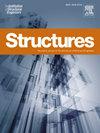Numerical simulation and load-bearing capacity of concrete-filled steel tubes strengthened with CFRP grid-reinforced ECC under axial compression
IF 3.9
2区 工程技术
Q1 ENGINEERING, CIVIL
引用次数: 0
Abstract
A numerical study on the compressive behavior and load-bearing capacity of the concrete-filled steel tube (CFST), strengthened with a carbon fiber-reinforced polymer (CFRP) grid-reinforced engineered cementitious composite (ECC), is presented. The numerical simulation, which was based on a previous test performed by the authors, indicated that an increase in the number of CFRP grid layers results in a significant increase in the bearing load on the concrete core. The confinement is provided to the concrete core by the strengthening layer only after the yielding of the steel tube, which occurs because of the contact pressure between the steel tube and ECC. Parameter studies that considered the effect of the number of CFRP grid layers and the strength of the CFRP, compressive strength of the ECC and concrete core, diameter-to-thickness ratio, and yield strength of the steel tube were conducted. The increase in fcu and decrease in Ds/t weakened the function of the confinement of the strengthening layer, and the influence of fcu was more significant. Furthermore, an analysis model that considered the nonlinear confining behavior and stress history for predicting the load-bearing capacity of the CFST columns strengthened with CFRP grid-reinforced ECC was established. The stress increment iteration method was employed to determine the varying confining pressure during loading. The proposed model showed high accuracy for predicting the load-bearing capacities of the strengthened columns.轴压下CFRP -网格- ECC加固钢管混凝土的数值模拟及承载力研究
对碳纤维增强聚合物(CFRP)网格增强工程胶凝复合材料(ECC)加固钢管混凝土(CFST)的抗压性能和承载能力进行了数值研究。数值模拟基于作者先前进行的试验,表明碳纤维布网格层数的增加导致混凝土核心的承载载荷显著增加。由于钢管与ECC之间的接触压力,只有在钢管屈服后,加强层才对混凝土核心提供约束。考虑碳纤维布网格层数与碳纤维布强度、ECC与混凝土芯的抗压强度、径厚比、钢管屈服强度的影响进行了参数研究。fcu的增大和Ds/t的减小削弱了强化层的约束作用,且fcu的影响更为显著。在此基础上,建立了考虑非线性约束行为和应力历史的CFRP - ECC加固CFST柱承载力预测分析模型。采用应力增量迭代法确定加载过程中围压的变化规律。该模型对加固柱的承载力预测精度较高。
本文章由计算机程序翻译,如有差异,请以英文原文为准。
求助全文
约1分钟内获得全文
求助全文
来源期刊

Structures
Engineering-Architecture
CiteScore
5.70
自引率
17.10%
发文量
1187
期刊介绍:
Structures aims to publish internationally-leading research across the full breadth of structural engineering. Papers for Structures are particularly welcome in which high-quality research will benefit from wide readership of academics and practitioners such that not only high citation rates but also tangible industrial-related pathways to impact are achieved.
 求助内容:
求助内容: 应助结果提醒方式:
应助结果提醒方式:


